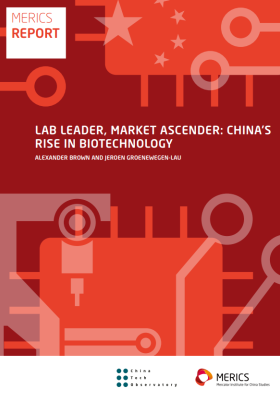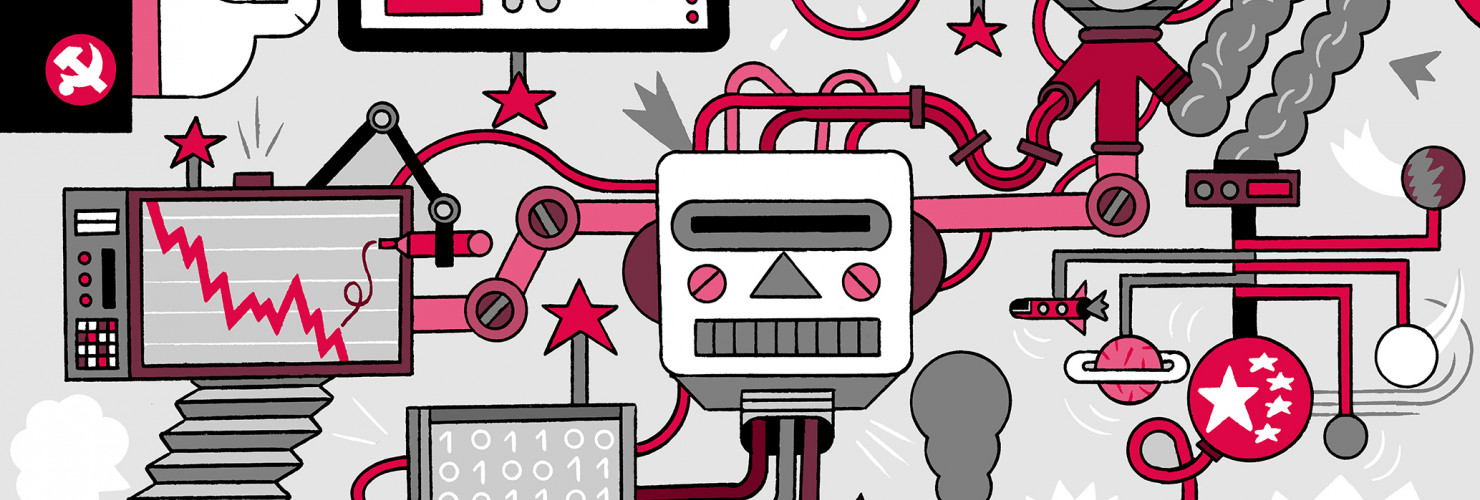

Executive Summary
You are reading the Executive Summary of the report "The party knows best: Aligning economic actors with China's strategic goals". Click here to go back to the table of contents.
The party state aims to return China to the center of the global economy
After a decade in power Xi Jinping has fundamentally reshaped China’s political economy and the nation’s reform path. The shifts currently unfolding in China’s economy are showcasing the systemic features of what China’s leaders today call “Chinese-style modernization” (中国式现代化) and how it will materialize at home and abroad. The impacts are visible in the domestic economy as the party expands its control over businesses in an attempt to align them, by hook or by crook, with national strategic priorities. Internationally, China’s relationship with liberal market economies is moving from integration to intense competition – and potential conflict.
Simultaneously reconfiguring the domestic economy and China’s international economic relations is generating frictions. Economic growth may be in a slump, but China is not in a crisis. A key factor is the downsizing of the real estate sector, which is part of a painful but necessary transition – and that means nobody should expect meaningful course correction. For better or worse, this is the development path put forward by Xi Jinping as the Chinese Communist Party (CCP) aspires to achieve “The Great Rejuvenation of the Chinese Nation” (中华民族伟大复兴) – the return of a strong and prosperous China to the heart of the global economy by 2049.
Policymakers and corporate leaders across the world are faced with a new environment in which China-induced risks and challenges abound. These encompass economic and tech competition, but also competition over markets and influence in the “global south”. By analyzing the structural shifts in China’s economic governance, this report aims to provide a better understanding of China's future path under Xi Jinping's strategic vision for the nation. It is likely that already significant differences between China’s economic model and those in Europe and other liberal market economies will continue to grow and create more friction. Observers should shed any wishful thinking of a return to pragmatism and focus less on hoping that Beijing will course correct itself. Instead, it is necessary to consider their own strategy to deal with a changing China.
The party has altered the political economy in pursuit of its strategic goals for the nation
During his first decade as China’s paramount leader, Xi Jinping steadily broke away from the political economy norms of his predecessors – Deng Xiaoping, Jiang Zemin, and Hu Jintao. Where the previous era was governed under a development-oriented political economy, Xi’s new era has been put under a geopolitically oriented political economy. Growth and socio-economic progress still matter in Xi’s China, just as catching up with the developed world technologically always mattered in the past.
However, Xi’s recalibration of the political economy first and foremost aims not at boosting China’s overall development, but rather at securitization – the pursuit of resilience in a geopolitically challenging environment – as the precursor to national “rejuvenation”. To realize such a vision, the party-state is increasing its control and guidance over economic actors to steer them towards three chief priorities throughout the intermittent period between now and 2049:
- Priority #1 – Attaining technological and supply chain self-reliance – Where possible, the CCP will endeavor to localize supply chains and close technology gaps to secure value chains within China’s own borders. The goal is to make it impossible for any other nation to hold China down through access to resources, technology, capital, or markets.
- Priority #2 – Reshaping and diversifying China’s international economic ties – Where China cannot localize supplies, such as for oil, gas, soybeans, iron ore, and critical raw minerals, the CCP aims to diversify suppliers to build resilience. The party state also seeks to diversify and develop export markets, and to take a central role in the global economy, especially as the self-proclaimed leader of the developing world.
- Priority #3 – Maintaining and strengthening China’s socio-economic base – While no longer the top priority for Beijing, development still matters. However, in recent years there has been a clear priority in managing risks in the domestic market like in real estate and deleveraging rather than prioritizing growth. Meanwhile, consumption growth has lagged despite Xi’s own calls for higher spending by households.
The party state strives for national rejuvenation with a new toolkit to steer economic actors along
Xi’s economic policies encompass Marxist-Leninist elements with a much stronger role for the CCP. The new political economy promotes an “all of nation model” that engages in a 21st century type of economic and technological mass mobilization. Party-state controls and guidance over economic actors were extended drastically, ensuring alignment with contributing to reaching national strategic goals. The measures include a mix of discipline system and incentives. Xi Jinping's policies focus less on profitability of companies or enriching the middle class. Instead, economic resources should be geared toward strategic sectors in the real economy – mainly high-tech manufacturing and emerging technologies such as AI. Sectors such as the real estate sector or consumer internet are seen as non-strategic and/or destabilizing, resulting in massive crackdowns over the past two years.
More party guidance has significant implications on the business environment of China’s private sector and entrepreneurs who occupy key roles in reaching high-tech supremacy. Ownership and governance models that help Beijing influence the steering wheel of companies have materialized, with golden shares securing veto-rights in some firms while party influence and window guidance pull on strings behind closed doors.
Meanwhile, sticks have been brought to bear against firms unaligned with Beijing’s goals, with crackdowns and rectification campaigns, blocked IPOs, and seemingly capricious (but actually orchestrated) regulatory enforcement beating prominent firms into line while sending a message to everyone else. At the same time, for the firms already in line with Beijing’s vision, carrots are ripe for the picking, like advantageous stock listings, protection from foreign competition, and access to everything from subsidies and cheap financing to the Little Giants Initiative – a government incentive to foster world leading high tech small and medium sized companies.
The private sector must follow the party’s lead
By prioritizing ideology over pragmatism, some have suggested that the CCP is now opposed to the private sector. To the contrary, Xi is not trying to undermine the private sector, he is aligning those that he needs to fall in line while rewarding those already on board. After all, tech rectification didn’t aim to kill the tech giants, but to align them with strategic goals and bring them into compliance with the evolving national security ecosystem – especially on cyber and data security matters.
The efficacy of this model has shown some success, as seen in some of China’s most technologically advanced and globally competitive firms, each of which are examined in case studies throughout this report:
- Alibaba, which, after taking a beating from a variety of Beijing’s sticks, has so aligned with the party-state agenda that it has broken itself into six different entities so that different lines of business can align with respective strategic goals, with a priority on tech self-reliance.
- Tencent, which has experienced blows from many sticks, and is not so subtly being told by regulators that are tightening down on the gaming sector including with a lengthy freeze on new approvals that it should focus less on the domestic gaming market and more on local tech gaps.
- Huawei, which needed no discipline from Beijing to get in line with national objectives, largely because it already was aligned with them. Instead of sticks, Huawei has enjoyed a bounty of carrots in the form of support and protection to close the tech gaps identified by Beijing.
- BYD, which was already fully in line with Beijing’s aspirations for the electric vehicle market and enjoyed extensive procurement favoritism, local subsidies, and a wide range of other carrots as it has skyrocketed in the home market even while it secures a global export and investment footprint.
- COSCO, which is already under the direct control of Beijing as one of the centrally owned SOEs, is not only already aligned with national strategies, but also enjoys tremendous support and protection at home. As it projects its home market advantages overseas, COSCO is playing a central role in China’s international shift, especially through the Belt and Road Initiative.
- GAC-Toyota, which as a sino-foreign JV must manage a delicate balance in terms of party-state control, largely benefits from benign neglect. In Beijing’s eyes, the company fulfills a role as an economic baseline holder that provides jobs, tax revenue, job training, etc. as it flies under the radar.
- Leaderdrive, one of China’s “Little Giants” that enjoys massive support through policy measures and through favorable state promotion, including in special financial markets. In many ways, smaller high-tech firms embedded in strategic technologies are co-opted and nurtured by the party state that seeks to accelerate their upward trajectory.
Stronger guidance is here to stay despite policy adjustments following weak growth
The current technology-centered agenda has set China on a clear trajectory, though its success is far from guaranteed. The sustainability of Xi’s path will be put to the test when ideology-driven ambitions clash with economic reality. The policy direction is effectively being implemented but the choices made come with trade-offs and economic costs.
GDP growth is waning, and China is running a serious risk of failing to unleash its potential thriving middle-class consumer market. The two big areas where resource allocation remains strong are in tech self-reliance and military modernization. But at the same time, productivity gains are stalling, despite aggressive industrial upgrading. That is not to say that the self-reliance campaign is not yielding results, but the productivity gains are secondary, and they add limited real productivity gains when all they have done is replace something they used to just import.
As Beijing approaches the 2023 Third Plenum – an event which could further indicate the direction of China’s overall political economy – it is critical to understand the context under which it is taking place. The leadership acknowledges the current economic challenges and the increasing pressure to shore up confidence. Recent minor policy shifts have given the impression of a return to pragmatic economic policymaking, but those few data points should not be interpreted as a break from a trendline that has taken shape over years.
Xi has given no indication that he intends to walk back the substantial strides the party has taken in the past decade to enhance its control over the economy. Although plenty in China and overseas may express frustration, Xi's economic vision remains steadfast. Policymakers and business leaders should plan accordingly.